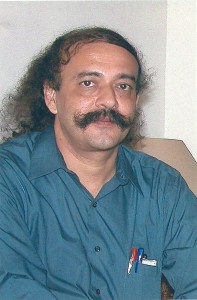 Jagdeep Desai is an architect and a full time academician. Presently, with Lokmanya Tilak Institute of Architecture and Design Studies, Kopar Khairane, Navi Mumbai. He was on the Publication Board of the Indian Institute of Architects, and was the Editor of the Journal of the IIA for a number of years. As a writer and correspondent, he was associated with the magazines, Architecture + Design, Inside Outside, and was the Aviation Correspondent for Business India in the mid 1980s. he has been invited at various conferences, seminars and symposium, to speak on education and the profession.
Jagdeep Desai is an architect and a full time academician. Presently, with Lokmanya Tilak Institute of Architecture and Design Studies, Kopar Khairane, Navi Mumbai. He was on the Publication Board of the Indian Institute of Architects, and was the Editor of the Journal of the IIA for a number of years. As a writer and correspondent, he was associated with the magazines, Architecture + Design, Inside Outside, and was the Aviation Correspondent for Business India in the mid 1980s. he has been invited at various conferences, seminars and symposium, to speak on education and the profession.
Following are the views by Jagdeep Desai, on Architecture Education
AL: Architecture Profession has changed over the last decade. New technology, new materials and new skill sets have emerged and posed the new challenges for architecture education in India.
In your view, what steps should educators and architecture institutes shall take to prepare students to meet the expectations of the profession and the new challenges?
JD: No doubt the technologies have not only changed, but in many ways, improved. But that is both notional and tangible. The main ones which are obvious is the computer aided drawing. This is an extremely useful technology to make the drawings, quickly, neatly, and in as many variations, and revisions, without much effort. At the same time, it is likely to be used very casually and taken for granted, and they danger of complacency is imminent.
The profession has not improved to the same level, the professionals expect too much from the fresh graduates, who in turn are totally at a loss in the profession, because they only know how to give commands to the computer, not realizing the CAD is not a Human Mind, which can think, the computer can only do what it is told to do.
The academicians are equally clueless, because the students expect spoon feeding and short cuts, and the attention span which was once forty minutes or so, is not around forty seconds. So the first challenge is to keep the focus and attention of these students, who are already on their mobile devices even before the class starts
AL: Teachers expect students to be creative and innovative, in what ways do you think even teachers can innovate and be creative within the framework of syllabus and guidelines provided by the Universities and the Council of Architecture?
JD: Just like professionals, the academicians must make use of the latest technology, but at the same time, should be careful not to let them be themselves be used by these.
Being experienced enough, they know that these are only tools, and not a substitute for the Human mind, certainly no substitute for one to one interaction, otherwise, teachers, professors, academicians would be redundant by now, and students would be self studying with online correspondence courses, etc.
Overall standards are falling, as even teachers nowadays are taking it extremely easy, the director of my previous college called it <minimalism>, make as little effort to give the bare minimum to the students.
Even now, teachers like even my students, do not stand, write, draw, sketch on the board and teach, but sit in the class and discuss the student presentations, or just put on some borrowed scanned drawings, put up the slides, and ask students to take them down, and go away for tea, etc.
Unless the academicians are personally involved and interested, no amount of technology can help.
AL: You think modern architecture is losing its social conscience? If yes, how can institutes and educators make students aware of their social responsibility?
JD: Lost it years ago.
As soon as the disposable packaging became popular, everyone, including students, clients, builders, authorities, want everything spoon fed, pre-packaged, and just for the matter at hand.
No one has time for other things, let alone, social conscience, except for a very few.
And with the proposal to shift Architecture from the Ministry of Human Resource Development to Ministry of Urban Development, this will simply assist the commercialisation of the profession altogether, social responsibility be damned.
AL: Please share your message for Architecture Educators.
JD: Friends in academics,
You already know, this is a much undervalued field, like all teaching.
So as to not lose the values and standards, we need to keep our own morale high, as well as our morals, which is even more difficult in these times. No teacher can afford to stop learning, which is definitely not available by qualifications alone. Use all available resources to keep informed.
Qualifications are hardly a substitute for practical experience, instead, they are being presented as if they count far higher.
In fact the matter of qualifications being mandatory for positions in teaching needs to be reviewed, and revised, so as to allow those experienced professionals to give their time and effort to the students.
And knowing how some faculty got higher qualifications, like purchasing online doctorates, others are post graduates from non recognised, and unrecognised universities and institutions, and then, using their position, are <regularised>, the entire system looks a farce.
But a dedicated teacher does not have to worry about these technicalities, and just carries on. To use the words of Field Marshal Sam MANEKSHAW, he told the Javaans, when they were entering the territory of the opponent, Bash on Regardless.
Reference to Sam Maneckshaw’s quote: (Page three of the following document)
http://www.ipcs.org/pdf_file/issue/1868066245IPCS-SpecialReport56-Chari-Manekshaw.pdf






